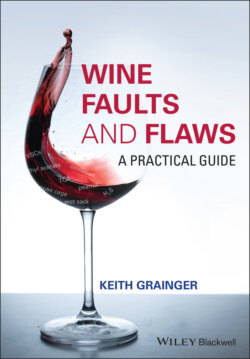Читать книгу Wine Faults and Flaws - Keith Grainger - Страница 67
2.6.1 Condition
ОглавлениеThe initial nosing of the wine will assess the condition: is the wine clean, or does it show a fault? The wine should not be swirled before this, and just one or two short sniffs are all that is required. Long and deep sniffs of a wine affected by 2,4,6‐trichloroanisole (TCA) or 2,4,6‐tribromoanisole (2,4,6‐TBA), or possessing high volatile acidity, would result in the taster's nose being desensitised for some time! Basically, at this point, the light nosing is to check if we want to go any further in the tasting procedure. Most faults and flaws are detectable upon the nose to a trained and experienced taster. Depending on the nature and severity of any fault revealed, a decision has to be made whether to proceed with the wine tasting or not. A nose that is free from faults is described as clean. It should be borne in mind that on occasions wines, particularly after some years in bottle, may smell somewhat unclean when first opened, a phenomenon sometimes referred to as ‘bottle stink’. This should dissipate after aeration. If there is doubt on this matter, the wine should be nosed again, having being swirled around the glass and allowed to ‘breathe’ for a few minutes.
Faults that are or may be detectable on the nose are shown in Table 2.2. This list is not exhaustive.
Table 2.2 Faults detectable on nose of wine.
| Olfactory indicator | Possible fault | Refer to: |
|---|---|---|
| Damp sack, wet cardboard, dusty, musty. Muted fruit | Chloroanisoles or Bromoanisoles | Chapter 3 |
| Earthy, beetroot | Geosmin | Chapter 14 |
| BAND‐AID® stables, faecal, animal, smoky, spicy | Brettanomyces related faults | Chapter 4 |
| Burnt, dried‐fruitcake, metallic | Oxidation | Chapter 5 |
| Struck match, burning on nose or back of throat | Excessive sulfur dioxide | Chapter 6 |
| Rotten egg, drains | Hydrogen sulfide | Chapter 6 |
| Garlic, gas, cabbage, sweetcorn, wet wool | Volatile sulfur compounds, lightstrike | Chapter 6 |
| Vinegar, balsamic | Excessive volatile acidity, ethyl acetate | Chapter 7 |
| Nail varnish, solvent | Ethyl acetate | Chapter 7 |
| Wax, loss of varietal character, wet‐dishcloth, mothballs | Atypical ageing | Chapter 8 |
| Vomit, rancid butter | Lactic acid bacteria associated faults. Diacetyl | Chapter 11 |
| Ash, charcoal, bacon | Smoke taint | Chapter 12 |
| Jammy ‘sweet’ nose | Heat damage | Chapter 14 |
| Beetroot | Geosmin | Chapter 14 |
